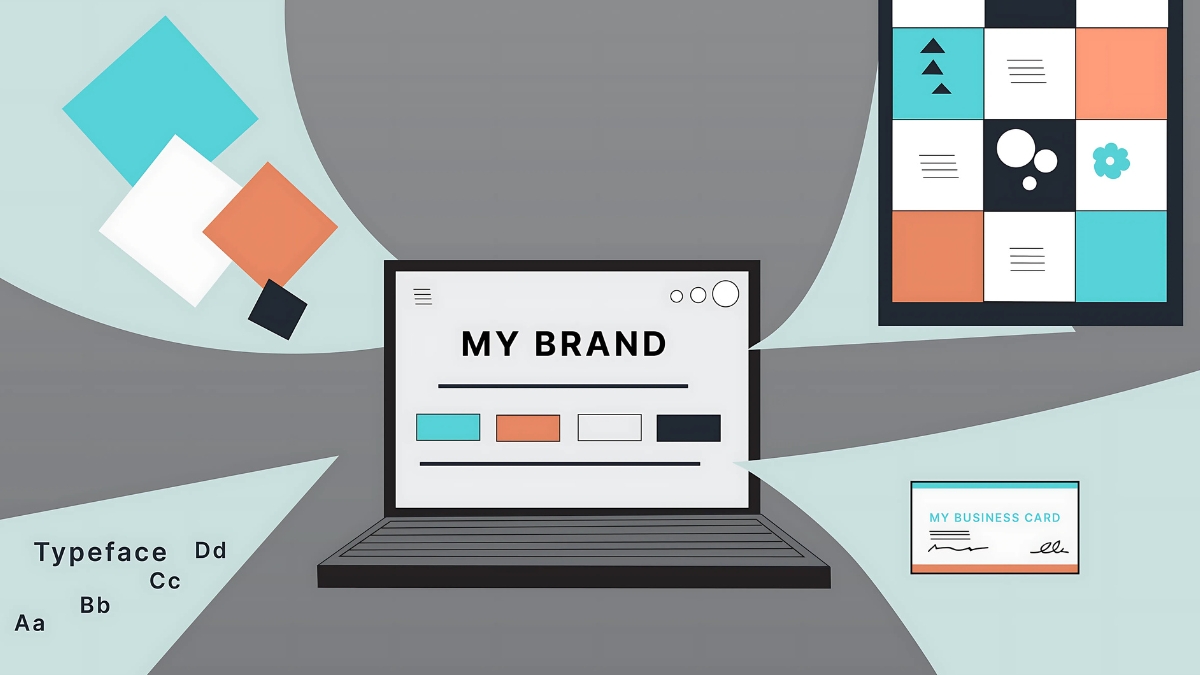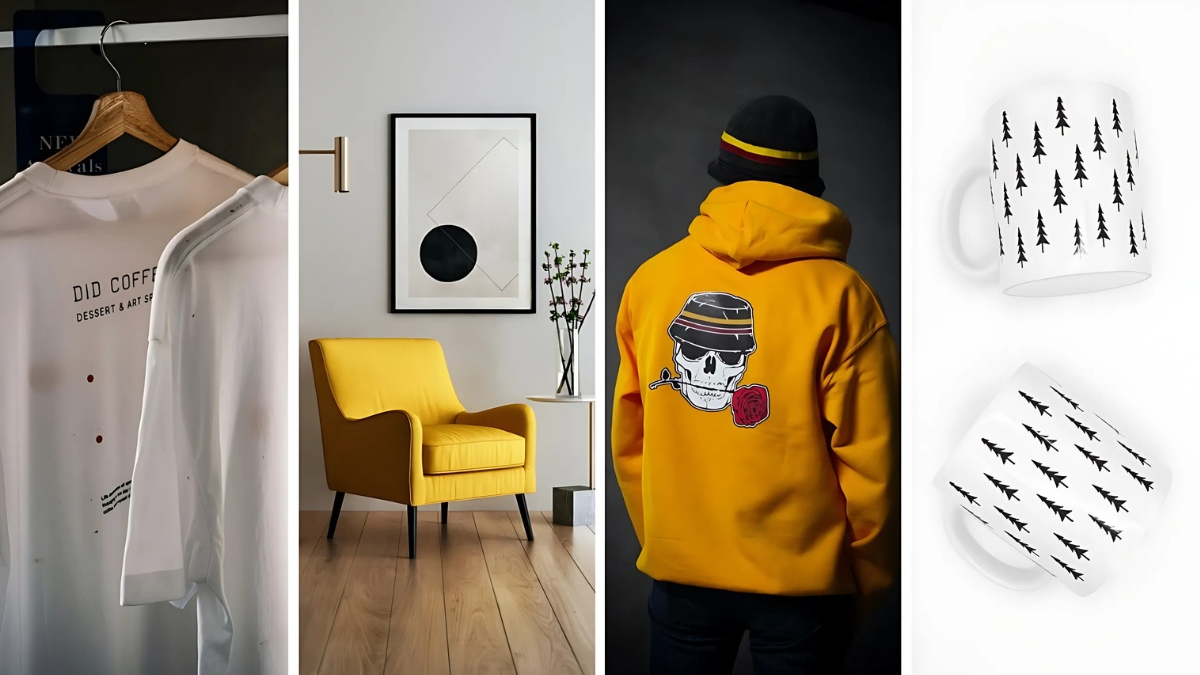
Print on Demand Branding Strategy: Build a Memorable POD Business in 2025
Did you know that the global print on demand market is projected to reach $39.87 billion by 2030? As more entrepreneurs enter this booming space, having a strong brand isn’t just nice-to-have – it’s essential for survival! In this guide, we’ll dive deep into creating a distinctive brand identity that sets your print on demand business apart from the competition. Whether you’re just starting or looking to refresh your existing brand, these strategies will help you build a memorable presence that resonates with your target audience.
Understanding Print on Demand Brand Fundamentals
When I first started helping companies develop their POD brands, I made a rookie mistake. I thought it was all about creating cool designs and slapping them on products. Boy, was I wrong! One of my earliest clients lost thousands of dollars because we focused solely on trendy designs without building a solid brand foundation. That experience taught me a valuable lesson about the importance of brand fundamentals.
Think of your POD brand like a house. The foundation isn’t the exciting part – nobody posts pictures of concrete footings on Instagram! But without it, everything else falls apart. I’ve seen this play out time and time again in the POD space.
The core elements of a successful POD brand identity start with your brand’s DNA. This includes your mission statement, values, and brand personality. I worked with a pet-themed POD brand that was struggling until we defined their mission: “Creating joyful products that celebrate the unique bond between pets and their humans.” That clarity changed everything about their approach, from design choices to marketing messages.
One of the biggest challenges in POD branding is standing out in an oversaturated market. I remember scrolling through hundreds of similar-looking t-shirt designs one day and thinking, “How does anyone break through this noise?” The answer lies in brand differentiation. The most successful POD brands I’ve worked with don’t try to be everything to everyone. They pick a specific niche and own it completely.

Take The Mountain, for example. They could have gone the route of generic animal prints, but instead, they became known for their hyper-realistic 3D animal designs. Their brand identity is so strong that people instantly recognize their products. That’s what we’re aiming for!
Your unique value proposition is crucial in the POD space. I learned this lesson while helping a client who was competing in the saturated motivational quotes market. Instead of trying to outdo everyone else’s inspirational messages, we positioned them as the brand for “introverted achievers” – focusing on subtle, minimalist designs with thoughtful messages. Their sales tripled within months because they found their unique angle.
The opportunities in POD branding are enormous if you get the fundamentals right. I’ve seen brands go from zero to six figures by focusing on brand consistency across all touchpoints – from their product designs to their unboxing experience. One client even turned their packaging inserts into collectible art prints, creating a whole secondary market for their brand!
Remember, your POD brand identity needs to work across all products. I once made the mistake of creating a brand identity that looked great on t-shirts but fell apart on phone cases and mugs. Now I always ensure the core design elements are versatile enough to work across multiple product categories while maintaining brand recognition.
The most successful POD brands I’ve worked with understand that it’s not just about the products – it’s about creating a complete brand experience that resonates with their target audience. Whether it’s through consistent visual elements, engaging brand storytelling, or exceptional customer service, every aspect needs to align with your brand fundamentals.
Let me tell you – getting these fundamentals right isn’t always easy, but it’s absolutely worth the effort. I’ve seen POD brands completely transform once they nail down these core elements. The key is to take your time, do the research, and build a solid foundation that can support your brand’s growth for years to come.
Developing Your Brand Positioning Strategy
You know what’s funny? When I first started working with POD brands, I thought creating target personas was just a fancy marketing exercise. Then I watched a client waste $5,000 on inventory that didn’t sell because we hadn’t properly defined their audience. Talk about an expensive lesson! Now I know better – your target audience isn’t just a vague concept of “people who might like your designs.”
I remember working with a client who insisted their target audience was “everyone who loves cats.” That’s way too broad! After some research, we narrowed it down to “professional women aged 25-40 who work from home and consider their cats part of their family.” The difference in marketing effectiveness was like night and day! Their conversion rates jumped from 1.2% to 4.8% because we were speaking directly to a specific persona.
Creating your brand story isn’t just about making up a nice tale. I learned this the hard way when helping a sustainable fashion POD brand. Their initial story was generic – “We make eco-friendly clothes.” Yawn! But when we dug deeper and shared the founder’s personal journey of transforming her wasteful fashion habits after visiting a landfill, that story resonated with people. Sales increased by 65% in the following quarter because customers connected with the authentic narrative.
Let’s talk about brand voice – this is where so many POD businesses stumble. I once worked with a client who tried to sound super professional and corporate while selling funny dog-themed products. It was like watching someone wear a tuxedo to a beach party! We shifted their voice to be more playful and casual, and their social media engagement tripled within weeks.
Finding your niche is crucial, and sometimes it finds you in unexpected ways. One of my favorite success stories is a client who started selling generic motivation quotes on t-shirts (like everyone else). After noticing that their science-themed puns were outselling everything else, we pivoted the entire brand to focus on nerdy science humor. Within six months, they had built a loyal following in the scientific community and were being featured in science magazines!

Your brand positioning strategy needs to be specific enough to be meaningful but flexible enough to grow. I worked with a POD brand that positioned themselves as “luxury home office accessories.” When the work-from-home trend exploded, they were perfectly positioned to expand their product line while maintaining their core brand identity.
The mistake I see most often is trying to compete on price or designs alone. A client once insisted that having the cheapest prices would be their positioning strategy. Instead, we focused on positioning them as the go-to brand for “mindful minimalists” – people who value quality and intentional design over price. Their average order value increased by 40%!
Voice and tone guidelines aren’t just documents that sit in a folder somewhere. They’re your brand’s personality in action! I helped develop guidelines for a fitness-focused POD brand, and we created specific examples for everything – from product descriptions to email responses. Even their error messages matched their motivational brand voice: “Oops! This page took a rest day. Let’s get you back on track!”
Here’s something most people don’t realize about positioning: it’s as much about what you say ‘no’ to as what you say ‘yes’ to. I once advised a client to turn down a large wholesale order because the products didn’t align with their brand positioning. It was hard to walk away from that money, but it protected their brand integrity, which paid off in the long run.
Remember, your positioning strategy isn’t set in stone. The POD market evolves quickly, and your strategy should too. But the key is to make intentional shifts based on data and customer feedback, not just chasing every trend that comes along. I’ve seen too many brands lose their identity trying to be everything to everyone.
Creating a Visual Brand Identity for POD Success
I’ll never forget my first major POD branding mistake. I designed this beautiful, intricate logo for a client with delicate line work and tiny details. It looked amazing on their website, but when we printed it on a t-shirt… disaster! The fine lines blurred together, and nobody could read the brand name. That taught me a crucial lesson about POD logo design: simplicity isn’t just good design, it’s essential for success.
When it comes to logo design for POD, you need to think about scalability in ways most businesses don’t. Your logo needs to look good on everything from a tiny label on socks to a large back print on a hoodie. I now follow what I call the “thumbnail test” – if your logo isn’t recognizable when scaled down to the size of your thumbnail, it needs work. One of my most successful clients has a logo that’s just two geometric shapes and their name in a clean font. Simple, but it works perfectly across their entire product range.
Color palettes are another area where I learned through trial and error. I worked with a brand that chose a beautiful, complex color palette with lots of subtle gradients. The problem? Every print provider produced slightly different results, making it impossible to maintain consistency. Now I always recommend selecting colors that can be reproduced reliably across different printing methods and materials.
Here’s a pro tip that saved one of my clients thousands of dollars: always test your colors on actual products before finalizing your palette. We once had to scrap an entire collection because the beautiful sage green we chose looked completely different on fabric than it did on screen. Now I always order sample prints of basic color swatches before committing to a full collection.
Typography is the unsung hero of POD branding. I remember working with a brand that used five different fonts across their products because they thought it made things more interesting. Their sales were struggling until we streamlined to just two fonts – one for headlines and one for body text. Their products immediately looked more professional and cohesive, and their sales reflected that change.
Let’s talk about mockups – they’re not just for show! I had a client whose sales were mediocre until we invested time in creating high-quality, lifestyle-focused mockups. We staged real photoshoots with their target audience in mind, and their conversion rate jumped by 35%. The key was showing their products in contexts that their customers could relate to, not just generic white-background product shots.

Design guidelines might sound boring, but they’re your brand’s secret weapon. I helped develop guidelines for a POD brand that included specific rules about design placement, size ratios, and white space requirements. Not only did this make their products look more professional, but it also made their design process much more efficient. They could create new collections faster because they weren’t reinventing the wheel each time.
One mistake I see often is not considering how designs will work across different product types. You might have a design that looks amazing on a t-shirt, but how does it translate to a phone case or a mug? I now always create a “product matrix” for my clients, showing how each design element should be adapted for different products while maintaining brand consistency.
The most successful POD brands I’ve worked with treat their visual identity like a living system, not a one-time project. They regularly review and refine their guidelines based on what’s working and what isn’t. One client even keeps a “design diary” where they document customer feedback about specific products and use that information to improve their future collections.
Remember, your visual brand identity isn’t just about looking pretty – it’s about creating a consistent, recognizable presence that builds trust with your customers. In the POD world, where anyone can upload a design and start selling, a professional visual identity is often what separates successful brands from one-hit wonders.
Building a Cohesive Product Line Strategy
I’ll never forget my first major product line disaster. I was helping a client launch their POD business, and we got so excited about creating designs that we ended up with 200 different products across 15 categories. Sounds great, right? Wrong! Sales were scattered, inventory management was a nightmare, and customers were overwhelmed. That experience taught me the power of focused product lines.
Here’s something most people don’t realize about POD product categories – less is often more. I worked with a client who was struggling with sales until we narrowed their focus from ten product categories to just three: home office accessories, wall art, and tech accessories. Their revenue actually increased by 40% because they could focus their marketing efforts and build a reputation in specific categories.
Let me tell you about a game-changing approach I discovered with collection themes. One of my clients was creating random designs based on whatever inspired them that week. Sales were okay, but nothing special. Then we started developing themed collections – each with a cohesive story and design elements that worked together. Their “Midnight Garden” collection, which featured dark florals across multiple products, sold out faster than anything they’d done before.
I learned a tough lesson about seasonal products when I helped a client create a massive holiday collection… in October. By the time we got all the products listed and marketed, we’d missed the peak shopping season. Now I follow what I call the “90-day rule” – planning seasonal collections at least three months in advance. It’s made a huge difference in capturing seasonal sales opportunities.
Speaking of evergreen products, here’s something interesting: I noticed that clients who maintain a 70/30 split between evergreen and seasonal items tend to have the most stable revenue. One successful brand I worked with keeps their bestselling minimalist designs available year-round while rotating in seasonal collections for variety. This approach provides consistent income while still capturing seasonal spikes.
Quality control in POD can be tricky – you’re not handling the products directly, after all. I once had a client receive complaints about fading designs because we hadn’t tested the artwork on different materials. Now I always recommend ordering samples from each print provider and creating a quality checklist. One of my most successful clients actually created a “quality bible” documenting acceptable standards for each product type.

Design consistency across product ranges is crucial. I remember working with a brand that had beautiful individual designs, but when displayed together, their products looked like they came from different companies. We developed a design system using consistent elements – specific line weights, a limited color palette, and recurring motifs. Their brand recognition improved dramatically, and repeat purchases increased by 25%.
Here’s a pro tip about product line expansion: I always advise clients to use the “bridge” method. When adding new product categories, ensure there’s a design element that “bridges” back to your existing successful products. A client who was known for their inspirational quote prints successfully expanded into phone cases by using the same typography and design elements, making the connection obvious to their customers.
Managing product lifecycles has taught me the importance of data. I help my clients track not just what sells, but when and why. One brand noticed their geometric designs sold better in winter months while their organic patterns peaked in spring. We used this information to adjust their product release schedule, resulting in more consistent sales throughout the year.
The most valuable lesson I’ve learned about POD product lines? It’s all about iteration. You won’t get it perfect right away, and that’s okay. Start with a focused collection, gather customer feedback, and refine based on real data. One of my most successful clients started with just 20 products in one category, perfected their approach, and then expanded thoughtfully. They now have over 200 products across five categories, but each expansion was strategic and based on customer demand.
Remember, a cohesive product line isn’t just about having matching designs – it’s about creating a complete brand experience that makes sense to your customers. Every product should feel like it belongs in your collection, whether it’s a seasonal item or part of your evergreen lineup.
Marketing Your POD Brand Effectively
I remember staring at my first client’s Instagram account with zero followers, wondering how we’d ever build a following. Then I discovered something game-changing: lifestyle photography is everything in POD marketing! We stopped posting just product mockups and started showing their t-shirts in real-world situations. One of our photos – showing a customer wearing their design while rock climbing – got shared by a major outdoor account, and boom! Sales jumped 300% that week.
Email marketing was my biggest learning curve in the POD space. I cringe thinking about the generic “New Product Alert!” emails I used to send. Everything changed when I helped a client segment their email list based on previous purchases and browsing behavior. We created specific flows for different customer types – art collectors got emails about limited edition prints, while gift shoppers received holiday gift guides. Their email revenue increased by 85% in just three months!
Let’s talk about packaging – it’s not just about protection anymore. I worked with a POD brand that was getting decent sales but very few repeat customers. We added branded thank-you cards and care instruction cards with their social media handles. Simple change, big impact! Their social media following grew organically, and their repeat customer rate went from 15% to 32%.
User-generated content is like gold in the POD world, but here’s the trick – you have to make it easy for customers to share. I helped a client create a branded hashtag and included a small card in each order encouraging customers to share photos wearing their designs. The best part? We offered a 15% discount on their next purchase for sharing. Within two months, they had hundreds of authentic customer photos to use in their marketing.
Social media strategy isn’t one-size-fits-all in POD. I learned this the hard way when I tried to replicate a successful TikTok strategy from one client to another. Totally bombed! The first client’s quirky pet designs worked great with fun TikTok trends, while the second client’s minimalist art prints needed the more curated atmosphere of Instagram. Now I always tailor the platform choice to the brand’s aesthetic and target audience.

Here’s a marketing secret that transformed one of my client’s businesses: creating “collection drops” instead of just adding new products randomly. We built anticipation through email teasers, social media countdowns, and even got micro-influencers involved. Their launch days started bringing in as much revenue as entire months used to!
Customer testimonials became a game-changer when we started using them strategically. Instead of just having a testimonials page, we started featuring specific reviews next to relevant products. One client saw their conversion rate increase by 28% after we added customer photos and reviews directly on their product pages.
The biggest mistake I see in POD marketing? Trying to be everywhere at once. I had a client who was struggling to maintain accounts on five different social platforms. We decided to focus 80% of their efforts on Instagram and Pinterest, where their target audience was most active. Their engagement rates tripled, and more importantly, their social media sales increased significantly.
Email sequences are crucial, but timing is everything. Through testing, I discovered that POD customers often need more touchpoints than traditional e-commerce before making a purchase. We developed a “warming” sequence that introduces the brand story first, then showcases design processes, and finally presents products. One client’s email conversion rate went from 1.2% to 3.8% after implementing this approach.
The most successful POD brands I’ve worked with understand that marketing isn’t just about selling products – it’s about building a community. I helped a client create a private Facebook group for their customers where they could share styling tips and suggest new design ideas. This group became their best marketing tool, with members becoming brand ambassadors who consistently shared their products with friends.
Remember, effective POD marketing is about creating a connection with your audience that goes beyond just selling products. When you nail your marketing strategy, your customers become your best marketers, sharing their experiences and bringing new customers to your brand organically.
Etsy Masterclass Downloads offers a comprehensive guide to mastering Etsy for sellers at any level. From setting up your shop to advanced marketing strategies, these resources are designed to help you maximize sales and grow your brand. Learn how to create standout listings, optimize SEO, and attract loyal customers. Perfect for those ready to take their Etsy business to the next level. Start your journey to Etsy success today!
Scaling Your POD Brand for Long-term Success
I remember when one of my clients hit a major scaling roadblock. They were doing great with t-shirts, but when they tried to expand into home decor, everything felt disconnected. Their brand started feeling scattered. The turning point came when we implemented what I call the “Brand Scale Blueprint” – a systematic approach to growth that kept their core identity intact. Every new product category had to pass through this filter before launch.
Systems are everything when scaling a POD brand! I learned this lesson the hard way when a client’s brand guidelines got completely lost in translation across their team of five designers. Sales were growing, but their brand consistency was falling apart. We solved this by creating a digital brand hub – a central location with everything from design templates to tone of voice guidelines. Their production speed doubled, and more importantly, their brand remained consistent across hundreds of new products.
Let me tell you about partnerships – they can be absolute game-changers! One of my clients collaborated with a popular Instagram artist to create a limited edition collection. Not only did sales skyrocket, but they gained access to a whole new audience. However, I’ve also seen collaborations go wrong. Another client partnered with an influencer whose values didn’t align with their brand, and their core customers felt alienated. The lesson? Choose partners who truly align with your brand values.
Trend adaptation is tricky in the POD world. I worked with a brand that jumped on every single trend they saw. They’d create products based on viral TikTok trends, only to be stuck with designs that felt outdated a week later. We shifted their approach to what I call “trend translation” – taking inspiration from trends but filtering them through their unique brand lens. Their bestselling collection came from combining the minimalism trend with their signature botanical style.

Here’s something most people don’t realize about scaling: your operations need to grow with your product line. I helped implement a project management system for a client who was struggling to keep track of design deadlines, marketing calendars, and product launches. It wasn’t the most exciting part of scaling, but it prevented so many potential disasters!
Strategic expansion is key. One of my most successful clients started in apparel but noticed customers asking for matching phone cases in their Instagram comments. Instead of randomly adding products, we launched a coordinated “tech accessories” collection that complemented their existing designs. Their average order value increased by 45% because customers could now create matching sets.
Data tracking became our secret weapon in scaling. We started monitoring not just sales numbers but also customer feedback, return rates, and social media engagement for each product category. This helped us identify which product types were actually worth scaling. One client discovered their lower-priced accessories had better margins and higher customer satisfaction than their premium products – this completely changed their scaling strategy!
The biggest lesson I’ve learned about scaling POD brands? It’s not just about getting bigger – it’s about getting better. A client once focused solely on adding more products until we showed them how improving their existing bestsellers’ presentations and marketing could drive more growth than launching new items.
Remember, successful scaling in POD isn’t just about adding more products or reaching more customers. It’s about building sustainable systems that allow your brand to grow while maintaining the quality and consistency that made customers fall in love with you in the first place. The goal is to grow strong, not just grow big.
Sometimes the best scaling decision is knowing when to say no. I advised a client against expanding into a trending product category because it didn’t fit their brand identity or production capabilities. Instead, we focused on deepening their existing product lines with new designs and variations. Their revenue still grew by 85% that year, and their brand remained strong and focused.
Building a successful print on demand brand requires more than just great designs – it demands a strategic approach to every aspect of your business. By implementing these branding strategies, you’ll be well-positioned to create a lasting impression in the POD market. Remember, your brand is your promise to customers, so invest the time and effort to make it exceptional. Ready to transform your POD business? Start implementing these strategies today and watch your brand flourish!





